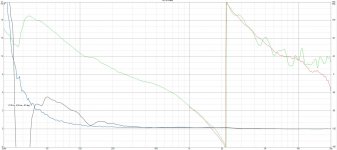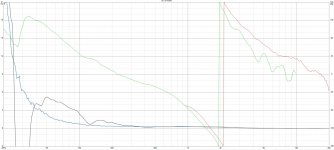Assuming I have it correct in that graph 1 has "excellent" phase tracking, how much worse or different would 2 and 3 be?
(graph 1 is an LR4 crossover at 2250Hz with a width of about 1KHz to 5KHz)
(graph 2&3 are LR4 crossovers at about 1600 and 2000Hz)
How close is close enough?
How much does it matter?
What are the implications of not have a crossover with "good" phase tracking, and for that matter, what is "good" vs. "bad" phase tracking?
What trumps, phase tracking or frequency response?
Or, you really need both?
(kinda like, what is more important to a drivetrain, engine or transmission...)
(graph 1 is an LR4 crossover at 2250Hz with a width of about 1KHz to 5KHz)
(graph 2&3 are LR4 crossovers at about 1600 and 2000Hz)
How close is close enough?
How much does it matter?
What are the implications of not have a crossover with "good" phase tracking, and for that matter, what is "good" vs. "bad" phase tracking?
What trumps, phase tracking or frequency response?
Or, you really need both?
(kinda like, what is more important to a drivetrain, engine or transmission...)
Attachments
I think you should try them out yourself and not listen to others what they think mathers*, that said, there are highly rated high end speakers that has poor phase track
*there is always those that can hear even the smallest change like the brand of solder or the insulation of wires
*there is always those that can hear even the smallest change like the brand of solder or the insulation of wires
I'm also interested to learn more about this topic. If the drivers sum well but the phase doesn't - what are the implications?
I guess goal is to either have matching phase for 2nd and 4th order filters, and a matching 90 or 270 degree phase difference for 1st and 3rd order filters?
I guess goal is to either have matching phase for 2nd and 4th order filters, and a matching 90 or 270 degree phase difference for 1st and 3rd order filters?
If the drivers do not sum [on axis], they do sum [vertically off axis] so the main lobe is aimed a bit upwards or downwards around the crossover frequency.
^ As TBTL says, the power distribution in the room remains after the response is fixed on the listening axis.
Frequency response, but you use phase in the process of getting the response right.
What trumps, phase tracking or frequency response?
Frequency response, but you use phase in the process of getting the response right.
So the whole point in looking at phase while designing a crossover is to see how the main lobe will be aimed?
If you aim slightly off the listening axis then compensate the listening axis response, then you increase the power, which modifies the DI through the crossover.
Last edited:
Assuming I have it correct in that graph 1 has "excellent" phase tracking, how much worse or different would 2 and 3 be?
(graph 1 is an LR4 crossover at 2250Hz with a width of about 1KHz to 5KHz)
(graph 2&3 are LR4 crossovers at about 1600 and 2000Hz)
How close is close enough?
How much does it matter?
What are the implications of not have a crossover with "good" phase tracking, and for that matter, what is "good" vs. "bad" phase tracking?
What trumps, phase tracking or frequency response?
Or, you really need both?
(kinda like, what is more important to a drivetrain, engine or transmission...)
It's very important in my opinion. It's the difference between a good speaker and a great speaker.
With that said, it's not the only important factor. The frequency response on-axis, off-axis, dispersion and an even power response is also a part of the equation. Distortion and the driver's working limits are also important.
But before even start considering the above, I think the most important thing is to have reliable high quality measurements including to have correct measurements of driver unit’s relative acoustical center off-set in order to have a chance of designing a successful x-over.
If you nail everything above, you will have a great coherent sounding speaker instead of a good sounding speaker.
I vote for the first example you describe.
Cheers,
/Göran
I find that not just the alignment, but the width of the alignment important in creating a speaker that vanishes, and sounds warm and inviting.
However, there is the Samuel Harsch crossover too, and it does not align the same way.
Best,
E
However, there is the Samuel Harsch crossover too, and it does not align the same way.
Best,
E
Dave, none of those examples are really considered 'bad' phase alignment. In fact, all of them are pretty good. If you look at how acoustic phase has to be graphed, it looks like it wraps on a 2D plot. This is really a misconception. The point at the top of the graph and the bottom of the graph are the same point on the phase plot, as phase should actually be plotted on a cylinder. If you mentally unwrap the phase in this case you should have 2 decreasing magnitude lines that basically come close to being an overlay. You have good phase alignment.
Also of note, is that this would be seen as an in-phase xover summation or that of likely a Linkwitz-Riley arrangement. This will make a deep pointed reverse-null in 4th order or higher rolloffs. 2nd order is more of a broad trough.
If these phase plots were 90 degrees separated, then this would be that of a Butterworth phase alignment. Usually the lobe is not straight forward in this case.
I tend to prefer an in-phase LR type of response as I feel it has more focus.
Another thing- the slope and the phase alignment dictate the type of alignment. You can have a rolloff that matches a BW or Bessel target, but if the phase does not then also reflect those alignments, then it's not a BW or Bessel.
Make sense?
Wolf
Also of note, is that this would be seen as an in-phase xover summation or that of likely a Linkwitz-Riley arrangement. This will make a deep pointed reverse-null in 4th order or higher rolloffs. 2nd order is more of a broad trough.
If these phase plots were 90 degrees separated, then this would be that of a Butterworth phase alignment. Usually the lobe is not straight forward in this case.
I tend to prefer an in-phase LR type of response as I feel it has more focus.
Another thing- the slope and the phase alignment dictate the type of alignment. You can have a rolloff that matches a BW or Bessel target, but if the phase does not then also reflect those alignments, then it's not a BW or Bessel.
Make sense?
Wolf
Dave, none of those examples are really considered 'bad' phase alignment. In fact, all of them are pretty good. If you look at how acoustic phase has to be graphed, it looks like it wraps on a 2D plot. This is really a misconception. The point at the top of the graph and the bottom of the graph are the same point on the phase plot, as phase should actually be plotted on a cylinder. If you mentally unwrap the phase in this case you should have 2 decreasing magnitude lines that basically come close to being an overlay. You have good phase alignment.
Also of note, is that this would be seen as an in-phase xover summation or that of likely a Linkwitz-Riley arrangement. This will make a deep pointed reverse-null in 4th order or higher rolloffs. 2nd order is more of a broad trough.
If these phase plots were 90 degrees separated, then this would be that of a Butterworth phase alignment. Usually the lobe is not straight forward in this case.
I tend to prefer an in-phase LR type of response as I feel it has more focus.
Another thing- the slope and the phase alignment dictate the type of alignment. You can have a rolloff that matches a BW or Bessel target, but if the phase does not then also reflect those alignments, then it's not a BW or Bessel.
Make sense?
Wolf
Yes, thank you.
Forum needs a like button.
David.
- Status
- Not open for further replies.
- Home
- Loudspeakers
- Multi-Way
- Importance of "Phase Tracking" in a crossover?


